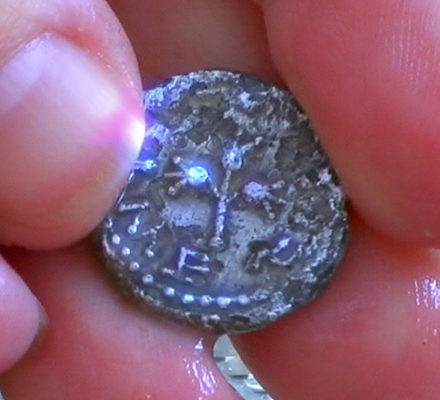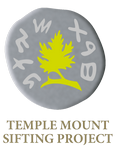Tag Archive for: Weights

Find And Finder Of The Month: July 2023, The Juarez Family from Mexico Found a Scales Beam Fragment
The Juarez Family with the scales beam
In July 2023, the Juarez family from Mexico discovered a fragment of a scales beam. As mentioned in our previous "Find of the Month" post, we are catching up on posts that were delayed due to the war.This…

Unique Weights Discovered in Temple Mount Soil Suggest Presence of Byzantine Church
Recently, the Temple Mount Sifting Project (TMSP) has completed the research and publication of two unique Byzantine coin weights discovered in the sifting. The two weights are of the very rare four keration denomination (about 0.6g). The first…

Giving our Half-Shekel
It's that time of year for giving the traditional charity reminiscent of the half-shekel donation to the Temple. Here's a little calculation of how serious that seemingly simple donation actually was! And some ideas for how to make your own half-shekel donation meaningful.

Find and Finder of the Month: Ivory Legs Found by Lev Simcha Levi
It has been quite challenging over the past year to keep posting a Find of the Month article each on a consistent basis, considering the slow pace of the sifting due to the numerous lockdowns and Covid-19 regulations and restrictions.…
Tag Archive for: Weights

50 Gr Weight of the State of Israel (20th Cent. CE)
A 50 gr weight of the State of Israel. The bottom of the weight exhibits scratch marks, above which was stamped an official seal — a set of scales and the year ’53. Scratch marks such as these were regularly applied in order to reduce the weight of overweight weights. The scratch marks are directly beneath the seal, and may have been placed there by the weights inspector who proceeded to stamp the weight.

100 Gr Weight of the State of Israel (20th Cent. CE)
A 100 gr weight of the State of Israel. Two small plaques are affixed at the bottom to correct the weight, one of them stamped with an official seal used from the 1970’s onward — a set of scales and the letter Yud within a star of David.

Broken Islamic Glass Weight
A broken glass weight of the Late Islamic period with remnants of Arabic inscription, original weight probably 1 Dinar.

1 Dirham Weight (10th – 11th Cent. CE)
A square bronze 1 Dirham weight, with Arabic inscription and tapered edges. Used for weighing silver Dirham coins. Hundreds of similar weights of the Fatimid era (10th–11th century CE) were discovered in Caesarea.

Imperial Byzantine 4-Keratia Glass Weight (6-7 century CE)
An “Imperial” glass weight of the Byzantine Period, used for weighing gold coins. Imprinted with a trio of saints and the cross shaped monogram of Theodosius III, of the early 8th century CE. Both the quality of the glass as well as the impression are strikingly similar to weights produced in European workshops and hence are likely of that origin.

An Official Four Kerátion Brass Weight (5th-6th Cent. CE)
A Byzantine Period bronze weight with a silver inlay Kerátion (English: carat; Latin: siliqua), for the weighing of silver coins. The Lettering KA may denote one Kerátion, and it indeed matches the weight of a Justinian II Siliqua coin of the 6th century CE.

Byzantine Numsima Bronze Weight (4th – 6th Cent. CE)
A Byzantine Period Numisma bronze weight for the weighing of gold coins. (4th–6th cent. CE).

Half of a Limestone Maneh Weight (late 4th cent. BCE – 70 CE)
Half of a flat cylindrical limestone weight. Second Temple Period. Based on the weight and size of the object, the complete weight would’ve had a weight similar to Maneh weights found in the vicinity of the Old City. The sifting has also unearthed disc-shaped lead weights, weighing ⅛ maneh belonging to the Hellenistic Period (3rd-2nd cent. BCE).


